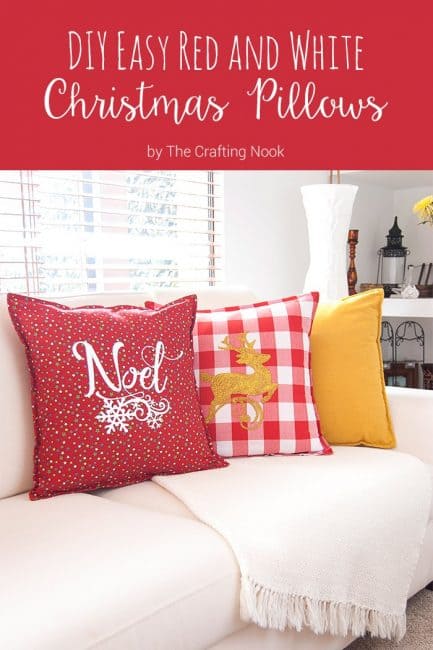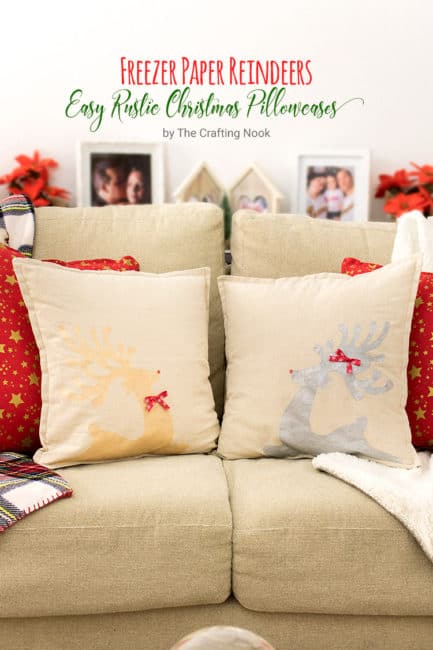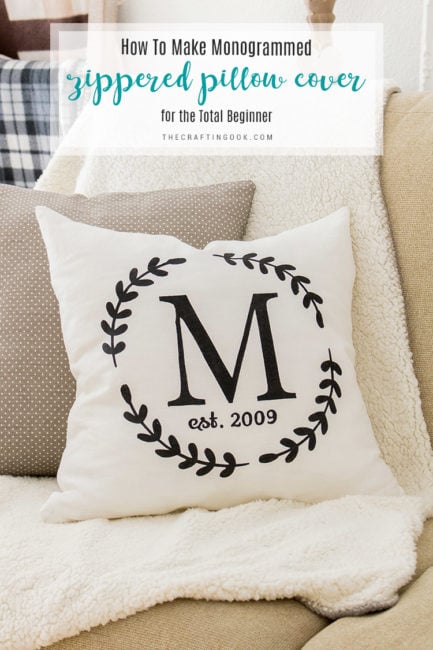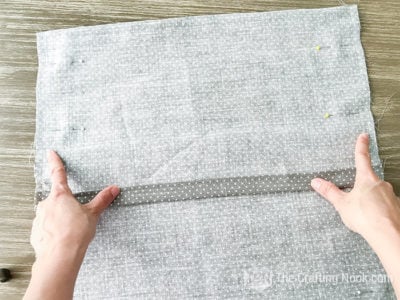DIY 10-minute Envelope Pillow Cover Tutorial
This super easy tutorial to make an envelope pillow cover is one of my favorites and the perfect beginner project if you’re on a tight budget or just want an easy sewing project to enjoy. This 10-minute envelope pillow cover is super easy to make, wash, and put back in use. What else can we ask for?
Don’t you love pillows? I’m kind of obsessed lately with pillows and I love having pillows everywhere. I just can’t help it whenever I see one, I need to buy them. They make such a difference in our home decor strategy.

Table of Contents
Make an Envelope Pillow Cover in 10 min
I have a problem. And the problem is that I love all the pillows I see and let’s face it, not all pillow designs fit our home and that’s when my struggles begin.
This post may contain affiliate links. Please read our Disclosure Policy.
My solution was simple, I buy the plain pillow and then make myself the covers.
Today I’m sharing with you the most basic and easy pillow cover you will find out there: A 10-minute envelope Pillow cover. From here you can tweak and variate in so many different ways as I have.
I’ve made quite some pillows already using different decorations and styles but to give you a starting point. I’ll teach you how to make this super easy envelope pillow cover and then stay tuned for more pillow covers tutorials as I’ll show you the different ways I’ve made them!

Seriously! This pillow cover was made in 10 minutes. Once you decide what size it will be, the rest is just easy peasy Lemos squeeze LOL. Sorry!
Actually, you don’t even need a sewing machine to make these pillow covers. You can hand-sew them really quickly too (it might not be 10 minutes but still quick).
If you would like a tutorial on how I hand-sew things let me know in the comments and I’ll happily put it together for you!
A few years ago, I made a whole Wall Diaper Stacker for my baby girl and I didn’t have a sewing machine then, so I’m honest when I say it’s not that hard, just slightly more time-consuming.
What is an Envelope Pillowcase or Pillow cover?
Envelope pillow covers have become very popular lately. While most pillowcases are open on the ends, an envelope pillowcase has a particular envelope closure at the back of the case that resembles an actual envelope. So, the pillow is tucked in and out of sight for a more finished look when decorating your couch or bed.

How to make an Envelope Pillow Cover with one piece of fabric in 10 min
Supplies:
- Your favorite fabric.
- A pillow insert (of course)
- Matching-color thread.
- Measuring tape or ruler
- Fabric marker or chalk
Tools:
- Sewing machine or needle (If you are going hand-sew)
- Scissors or rolling cuter
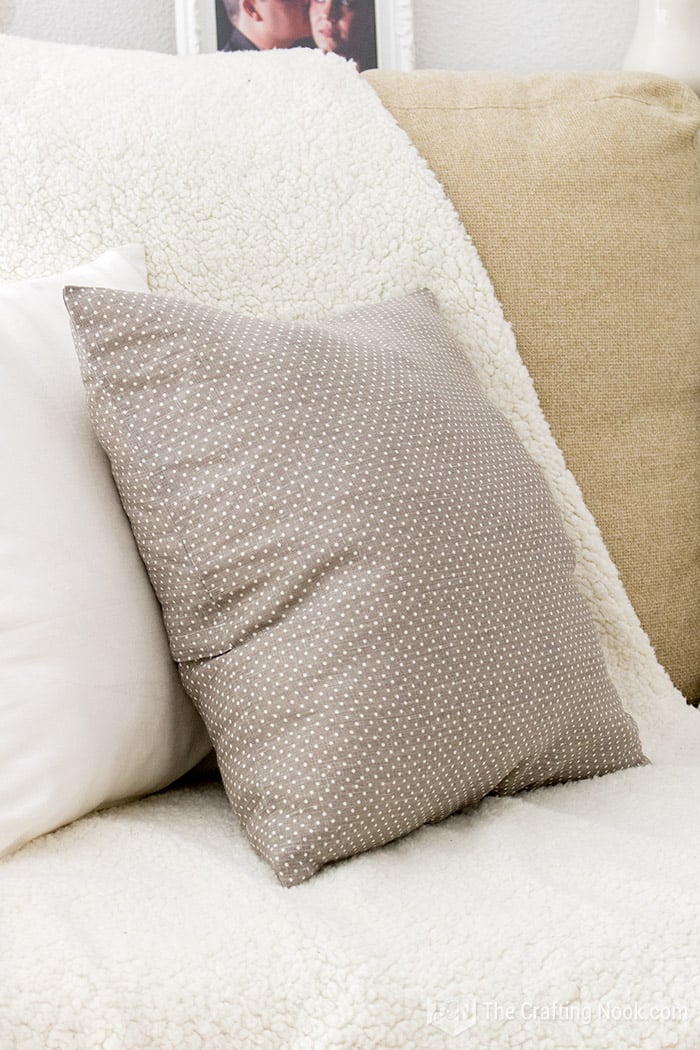
Instructions:
Before we begin, be sure to follow us on Pinterest, Facebook, Instagram, and YouTube, and also sign up for our email list (at the end of this post), so you’ll never miss a post!
I’ll start by showing you some graphics of how this works so you have a better idea on how to determine the size of your pillow and then I’ll share a step-by-step photos tutorial, alright?
Wanna know the best part of this envelope pillow cover?
Prepare yourself for awesomeness…
A while ago, I would cut 3 separate fabric pieces, as I did for these Christmas Pillow covers (2 for the back and 1 for the front panel), and pin them together (I also love Laura’s technique, so clever!). Ha.
Now, (Ready???) improved envelope pillow covers to ONE piece.
You heard that right. ONE piece. Front piece and back pieces all in one piece.
Nice huh!
Step 1: Prep Work
Let’s start with the envelope pillow cover pattern. There’s no need for a printable since it’s all about your pillow’s size and some math.
Here’s how the math works and how you will be cutting your fabric as follows:
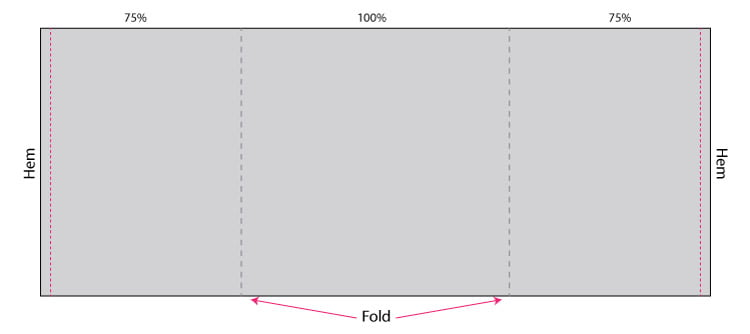
100% means your pillow’s size (1/8-inch seam allowance only on top and bottom because you are folding sides).
75% means the percentage of the front size you will use for the back pieces. You can use less but I love thick hems on the ends and large overlap. So, you can adjust as you like you can use 65% for example if you like thin hems.
In a life example, if your pillow is 16×16 Inches, your 100% would be about 16 x 16.6 Inches and then your back panels (75%) would be about 12 x 16.6 Inches. Sum all the widths and you have the length of your main piece.
From there, it’s just about folding and stitching basically. Double fold your hems and then fold and stitch the pillow cover.
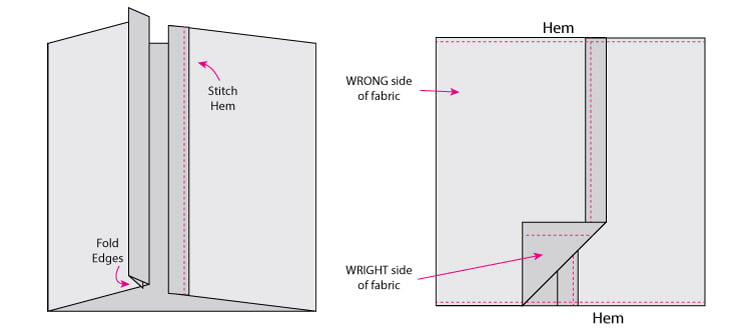
Step 2: Trace your pattern onto the fabric
- Once you cut your fabric with the right measurements, make sure you marked well your folding lines.
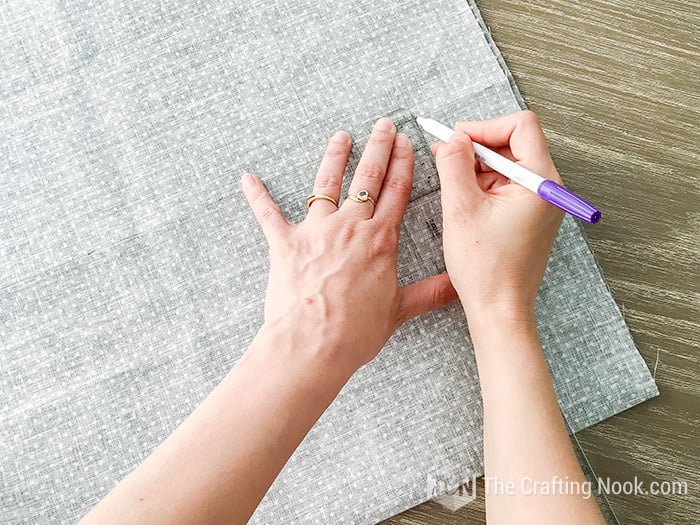
- Iron your fabric. This isn’t necessary, but it will make your sewing job so much easier if you do!
Step 3: Mark The foldings
- Fold the fabric with the right sides together. Fold one of the short sides over, make sure it’s straight, then fold the other side over.
- Iron to mark folding lines and pin in place close to the folding line.
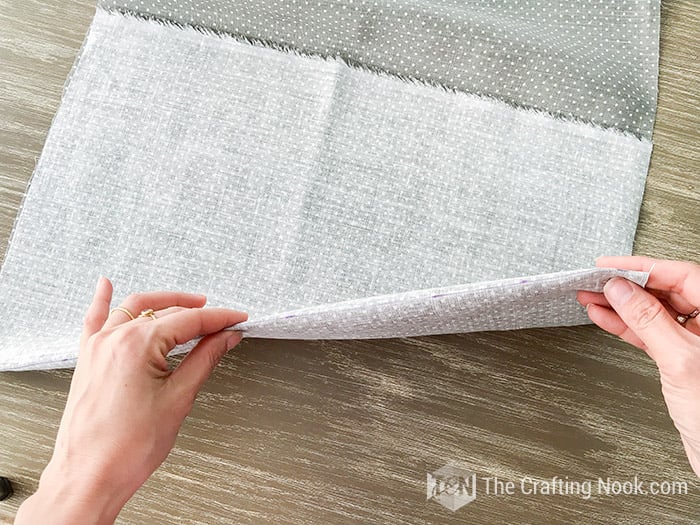
Step 4: Stitch the end’s Hems
- As I mentioned I love thick hems, so I made it a little less than 1 inch. So, measure it, fold it once and fold it again.
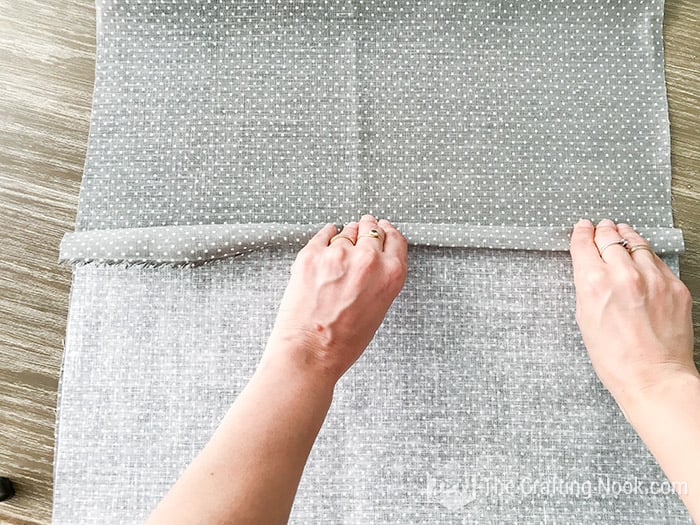
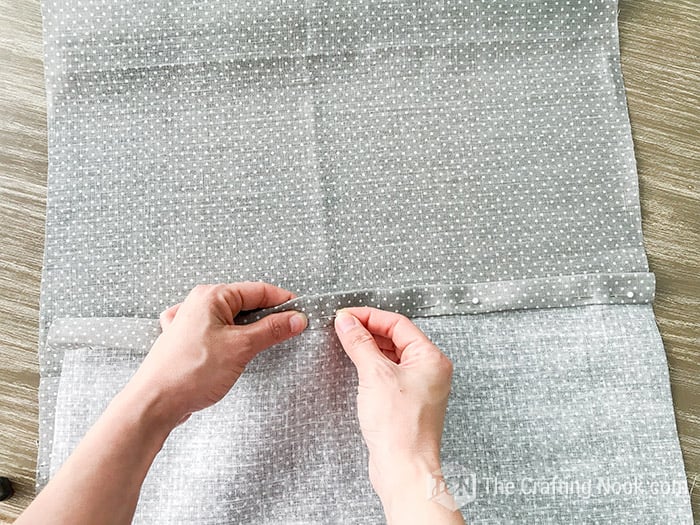
- Lay them in place to make sure you like them or if you want to give more or less to the hems.
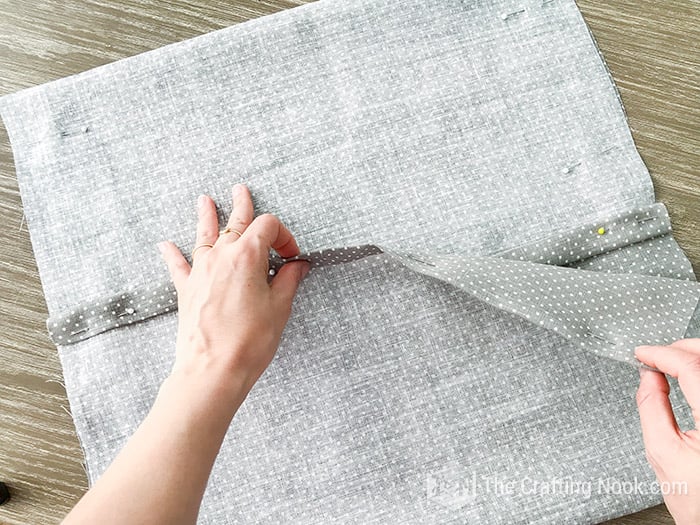
- Iron it. Pin it. Sew it. Repeat on the other end.
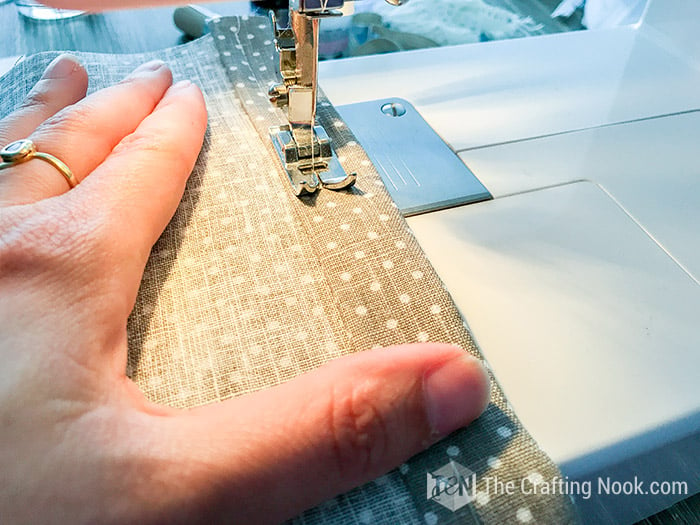
Step 5: Assemble the envelope pillow cover
- Check the width; it should be the width of the pillow (16” in my case). Adjust until it’s right, and pin along the top and bottom.
- When everything is ok there, then sew two straight lines (I do reverse the machine and go over each finished end again for reinforcement since that’s where the pillow gets the most abuse from inserting and removing the pillows, but that takes maybe an extra 5 seconds). Did I mention this was a super easy project?
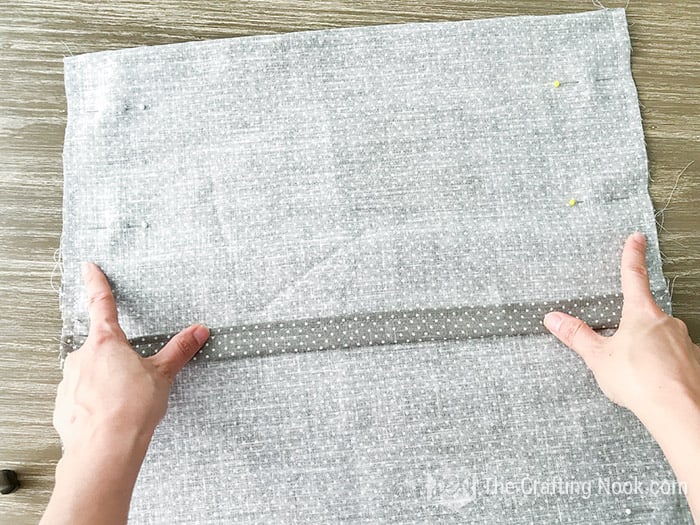
- I like zig-zag stitches along the edges to avoid fraying and have a nice finished edge.
- Turn the envelope pillow cover right side out. Iron it.
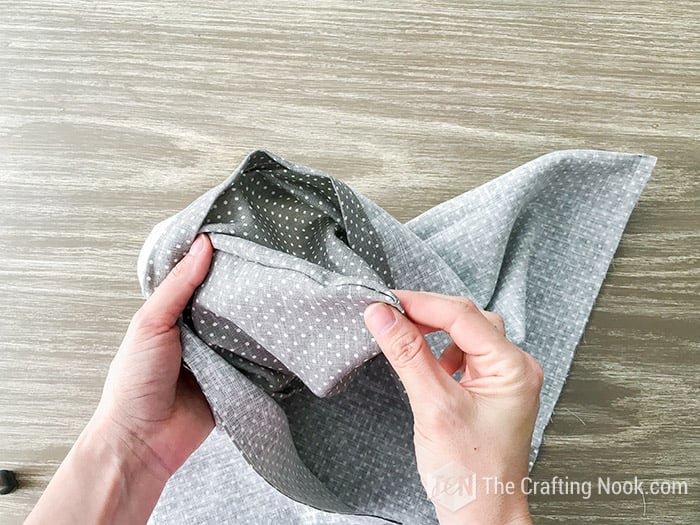
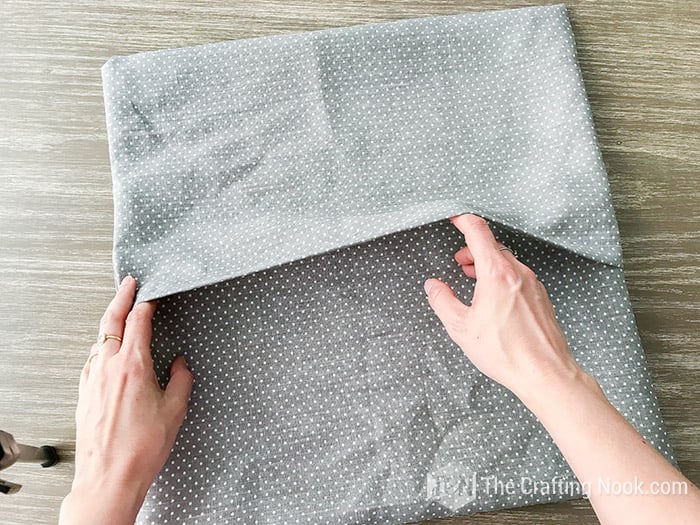
- Stuff it with a pillow, and enjoy your finished work.
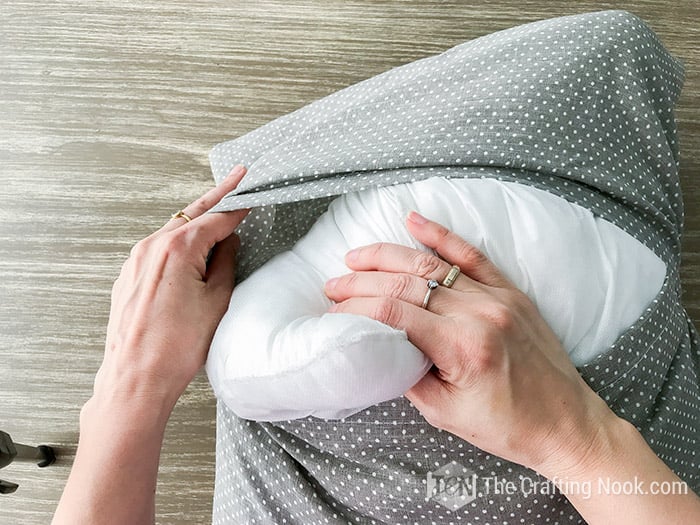
Isn’t it Pretty and easy?
Now you have a brand-new throw pillow!
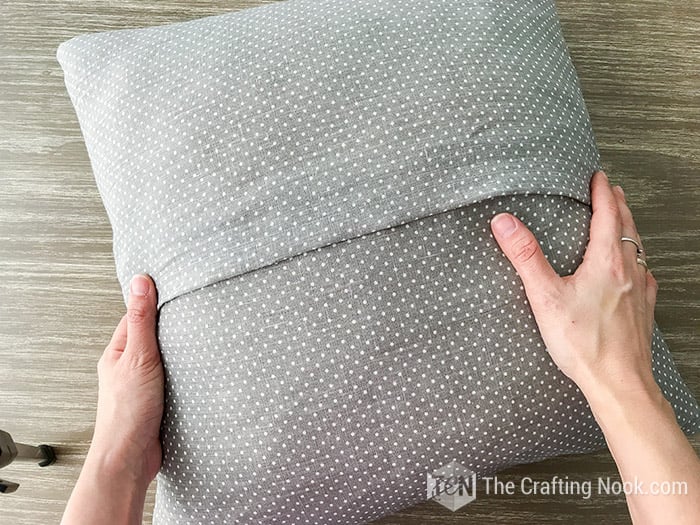
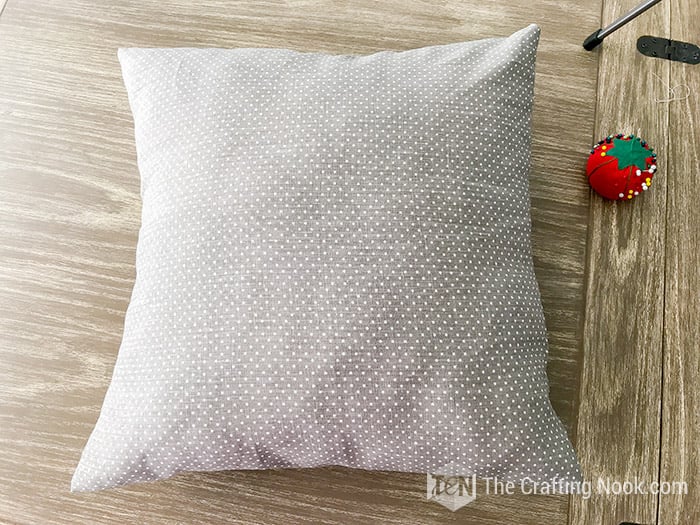
This way you can make as many as you want and then start playing around like I did.
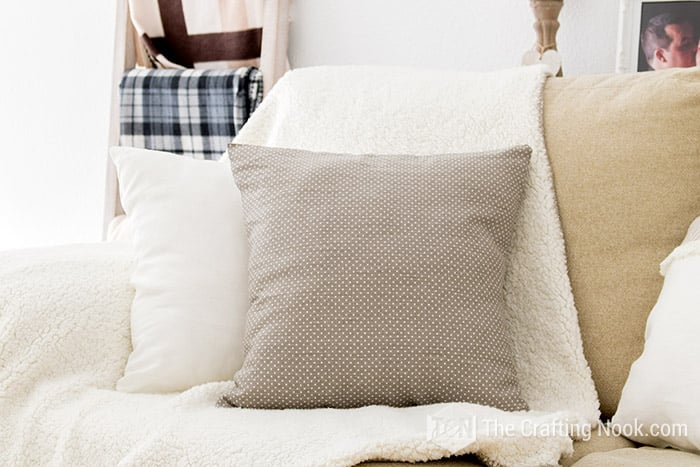
I made another one stenciled and then another one part stripped and part solid with a cute tassel ribbon in between. SOOO cute!

You should try. I’ll be sharing the tutorial for these cute pillows and also how I make zipper pillow covers! So, stay tuned!
There you go!
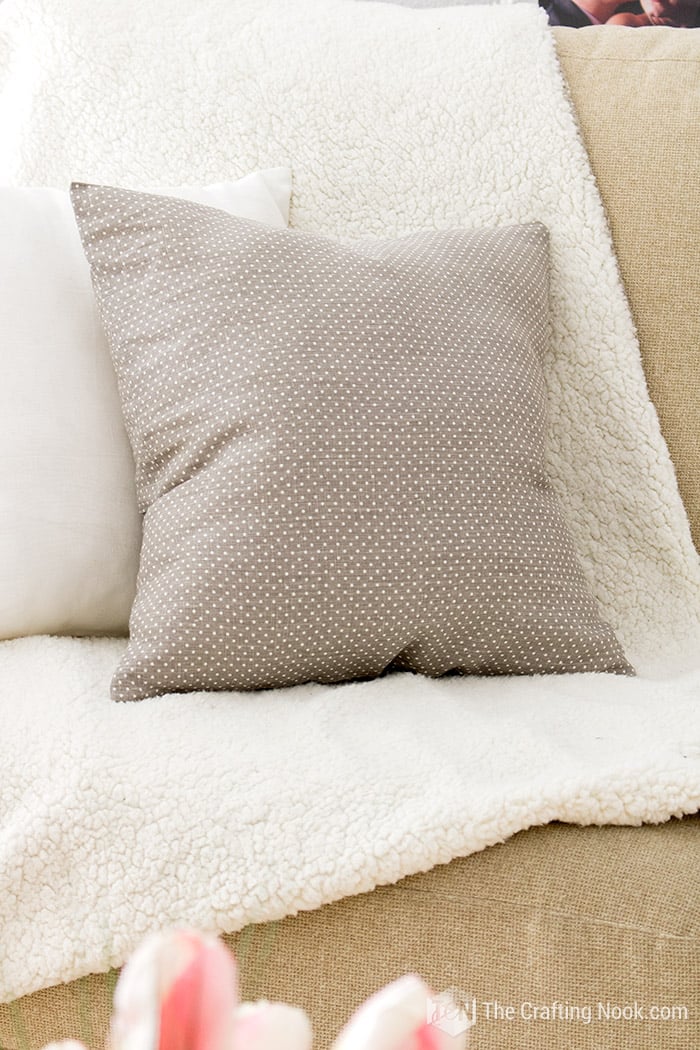
What do you think?
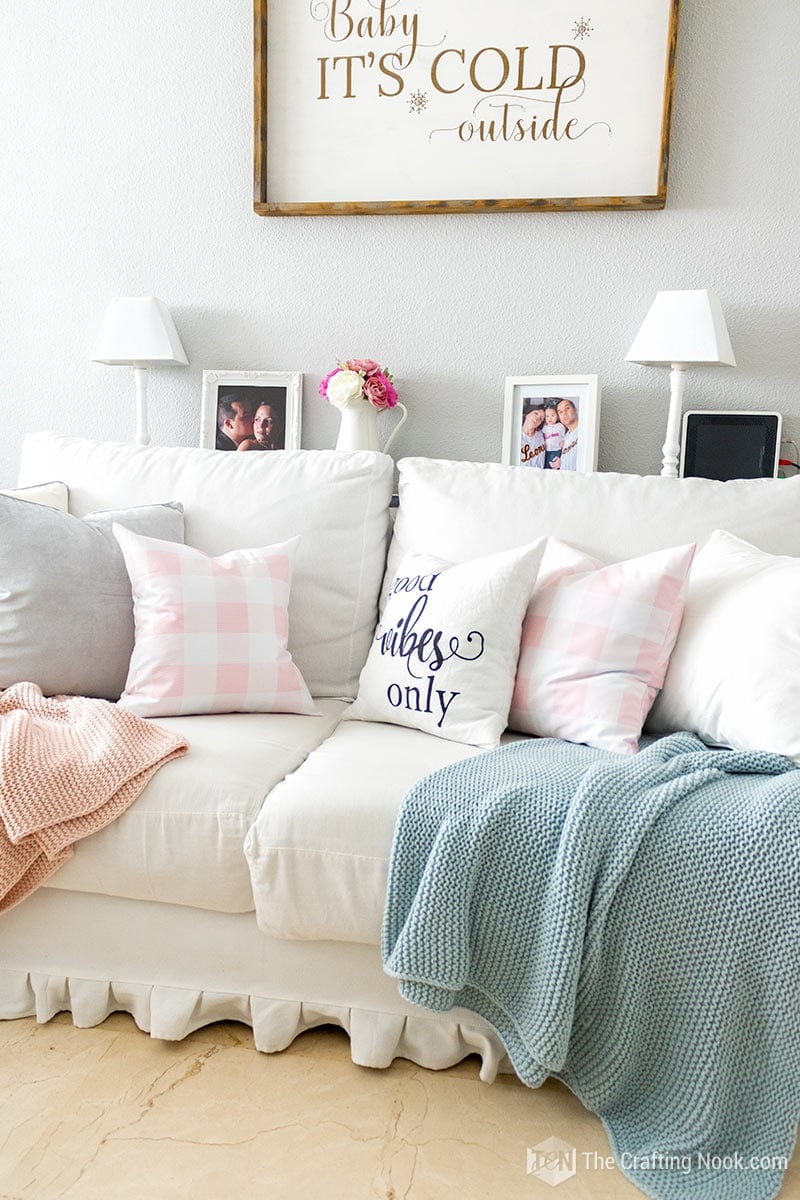
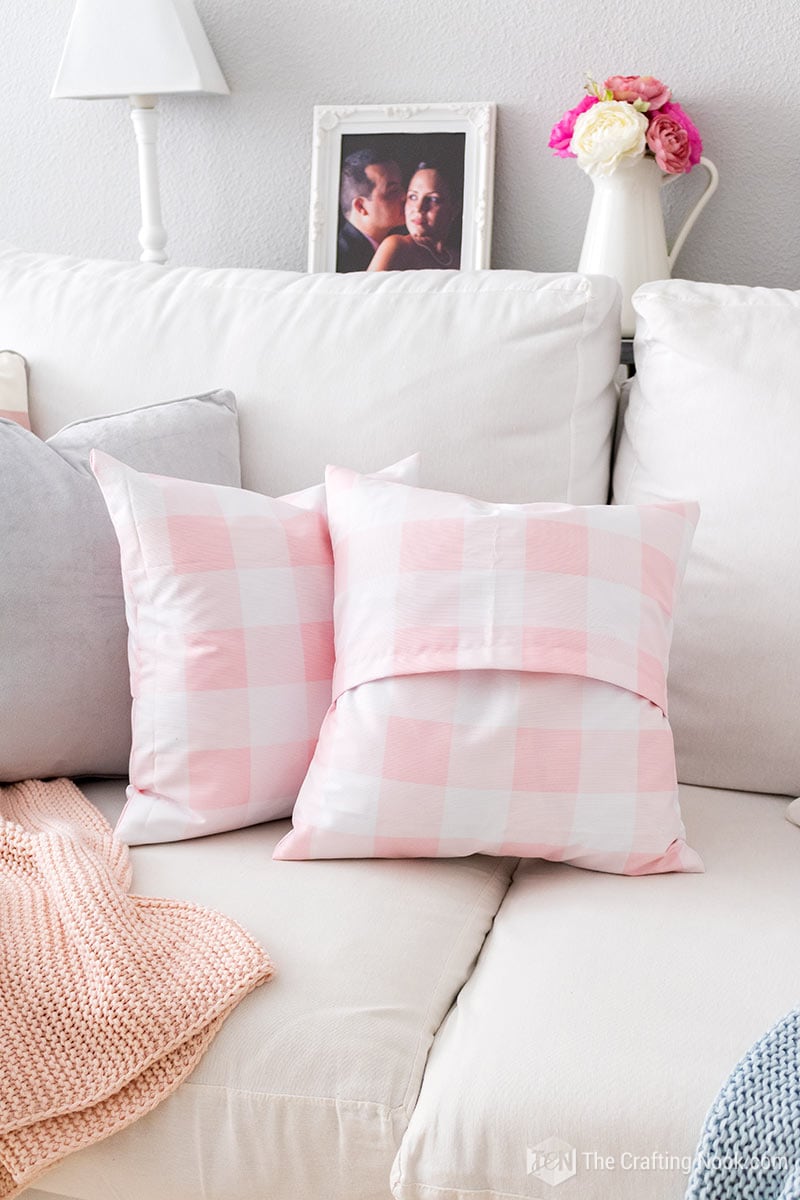
Sewing Tips
For Perfect Envelope Pillow Covers
- I so recommend cutting the fabric with the use of a rotary cutter, acrylic ruler, and a cutting mat. I started doing this just a couple of years ago and OMG, what a difference. If you don’t have those, you may think you can just cut with scissors but I assure you, a rotary cutter kit will make your life infinitely easier. You won’t regret it.
- Whenever possible, if you are a beginner, use 100% cotton fabrics. This is the easiest fabric to work with. If you’re not experienced with making pillows, I recommend waiting until you have a bit more experience with them to work with more complex fabrics.
- Always have more fabric than necessary. Don’t just buy the amount of fabric you need, especially when you are a beginner. That way you know that if something goes wrong, you have more fabric to try again.
- Start with a brand-new needle for your sewing machine and new thread. Old needles can lead to all sorts of problems. Make sure the needle is sharp and made for cotton fabric. Keep those threads your grandma gave you for other types of crafts and make sure you use brand new threads to sew with your sewing machine.
- Seam ripper handy at all times. Whenever you need to undo some stitches, this tool will save you tons of time. But be careful and don’t underestimate it, it’s very sharp.
How can I style this Pillow cover?
- Mix with other pillows on your sofa or couch.
- Iron on some pretty designs.
- Stencil paint some pretty sentiments.
- Place a blanket underneath the pillow on a reading chair.
- Mix and match colors on your bed.
If you make some, please tag me so I can check it out and share your project!
Frequently Asked Questions
This tutorial is suitable for all levels. Even if you have never sewn before, this project can be done.
Envelope pillowcases are perfect for square pillows at any size, but it works on rectangular or even circular pillows by adjusting the size and shape of the fabric based on the size of your specific pillow form.
Absolutely! As long as the fabric you choose is washable, your pillow cover will be totally washable.
More Sewing Projects to Try
Like this Envelope Pillow Cover project? You might definitely love these other sewing project ideas too:
✂️ Tutorial

DIY 10-minute Envelope Pillow Cover Tutorial
Tools
- Sewing Machine
Supplies
- Your favorite fabric.
- A pillow of course, :p
- Matching-color thread.
- Sewing machine or needle If you are going hand-sew
- Measuring tape or ruler
Instructions
You will need to cut your fabric like follows:
- 100% means your pillow’s size (hem allowance only on top and bottom because you are folding sides).
- 75% means the percentage of the front size you will use for the back panels. You can use less but I love thick hems on the ends and large overlap. SO you can adjust as you like you can use 65% for example if you like thin hems.
- In a life example if your pillow is 16×16 Inches, your 100% would be about 16 x 16.6 Inches and then your back panels (75%) would be about 12 x 16.6 Inches. Sum all the widths and you have the length of you main piece.
- From there, it’s just about folding and stitching basically. Double fold your hems and then fold and stitch the pillow cover.
- Let’s go to the details shall we?
- Once you cut your fabric with the right measurements, make sure you marked well your folding lines.
- Iron Your Fabric. This isn’t necessary, but it will make your sewing job so much easier if you do!
- Fold the fabric with right sides together. Fold one of the short sides over, make sure it’s straight, then fold the other side over. Pin in place close to the folding line.
- Work on the hems: as I mentioned I love thick hems, so I made it a little less than 1 inch. So measure it, fold it once and fold it again. Iron it. Pin it. Sew it. Repeat on the other end.
- Lay them in place to make sure you like it or if you want to give more or less to the hems.

- Check the width; it should be the width of the pillow (16” in my case). Adjust until it’s right, and pin along the top and bottom.
- When everything is ok there, then sew two straight lines (I do reverse the machine and go over each finished end again for reinforcement since that’s where the pillow gets the most abuse from inserting and removing the pillows, but that takes maybe an extra 5 seconds). Did I mention this was a super easy project?
- I like zig-zag stitching along the edges to avoid fraying.
- Turn the envelope pillow cover right side out, stuff it with a pillow, and enjoy your finished work.

If you like this simple yet super fun and decorative project please share it with your friends!
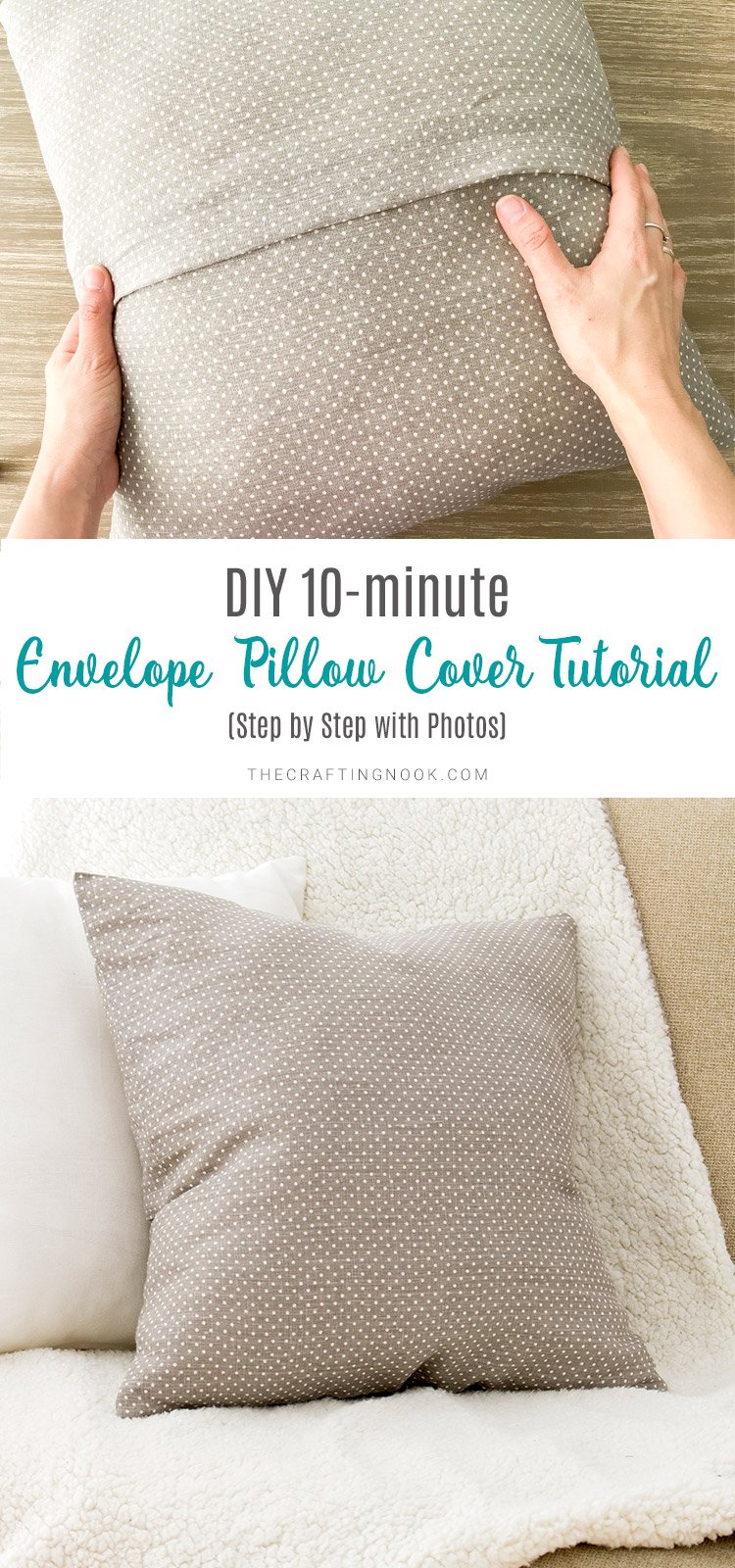
Til’ next time…

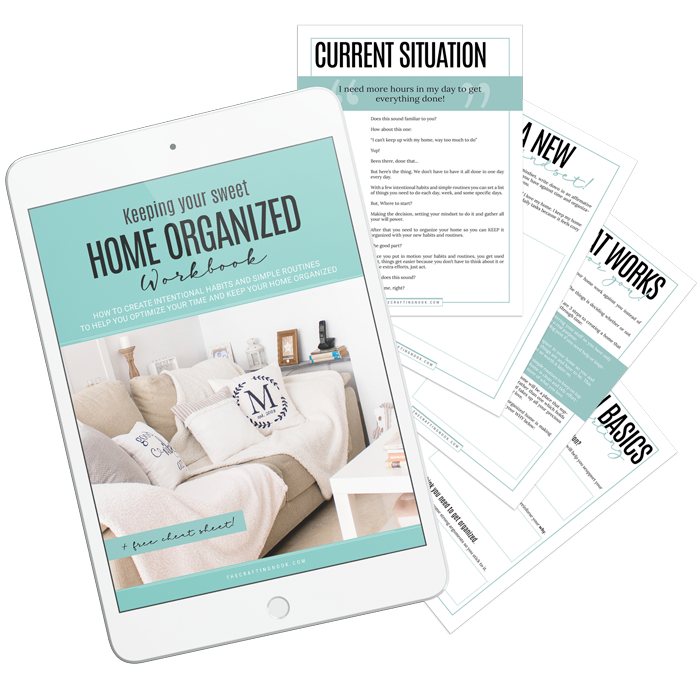
FREE WORKBOOK
Keeping your Sweet Home Organized
Learn how to create intentional habits and simple routines to Keep Your Home Organized. Plus freebies, printables, exclusive content, and tips.
Disclaimer: By clicking on the “Yes” button above you are giving me your consent to collect and use your information according to the law and My Policy Privacy. Zero Spam I promise!
